| Pages:
1
2
3
4
5
6 |
nezza
Hazard to Others
  
Posts: 324
Registered: 17-4-2011
Location: UK
Member Is Offline
Mood: phosphorescent
|
|
Here's a picture of various cobalt (III) complexes I have prepared in solution.
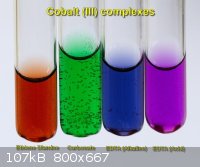
|
|
|
sargent1015
Hazard to Others
  
Posts: 315
Registered: 30-4-2012
Location: WI
Member Is Offline
Mood: Relaxed
|
|
And that is beautiful! Where did you obtain your ethylenediamine?
|
|
|
bfesser
Resident Wikipedian
    
Posts: 2114
Registered: 29-1-2008
Member Is Offline
Mood: No Mood
|
|
Quote: Originally posted by Acidum  | Call me grammar/iupac/nerdy nazi, but I just can not look at titles and swallow "aspirinate" as proper name, especially from someone with master in
chemistry who actually does research. And referring to ASA as "aspirin" as well. I would definitely be happier if You (or admin/mod) could rename
threads at least to "acetylsalicylates (aspirinates)".
In Serbia, acetylsalicylic acid is more often sold as "Andol", "Anbol" and "Midol". If I put my results here, should I refer to them as "andolates,
anbolates and midolates"? Or "polyandolate"... |
We covered this in the first thread on the topic:
Quote: Originally posted by Sauron  | I can't say I approve of referring to salts of acetylsalicylic acid as aspirinates.
Aspirin is a chemically meaningless trade name (Bayer) gone generic.
There is no aspirinic acid.
Call it what it is: Copper (II) acetylsalicylate. I can't help it if that does not fall trippingly off the tongue. |
Quote: Originally posted by bfesser  | | I don't really care for the name either, but that 's what it's referred to in most of the literature. Personally, I'd prefer dicopper
2-acetyloxybenzoate (IUPAC) or just copper(II) acetylsalicylate as you've said. |
|
|
|
sargent1015
Hazard to Others
  
Posts: 315
Registered: 30-4-2012
Location: WI
Member Is Offline
Mood: Relaxed
|
|
Hehe someone always has to question the naming 
|
|
|
sargent1015
Hazard to Others
  
Posts: 315
Registered: 30-4-2012
Location: WI
Member Is Offline
Mood: Relaxed
|
|
Well, more updates, I attempted the Cobalt (II) aspirinate and the Cobalt (III) aspirinate syntheses and both behaved poorly.
The cobalt (II) never crashed out of solution upon cooling, as per the paper given above. I will try boiling off the solvent, but I fear that may
decompose the product, but it can't hurt on the small scale I ran.
The cobalt (III) was actually my carelessness that caused it to fail, forgetting to fully dissolve the the acetylsalicylic acid and the sodium bicarb
BEFORE throwing it into the cobalt solution
Also, This is the final product of the cobalt (III) carbonato (yeah, yeah, poor naming, but I don't care) synthesis. I did not record the yield since
my cobalt chloride was already wet before the synthesis.
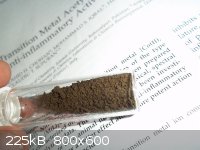
Very cool olive colored powder
Also, I don't know if I have shown off my copper (II) aspirinate, which is a beautiful aqua color:
[Edited on 1-7-2013 by sargent1015]
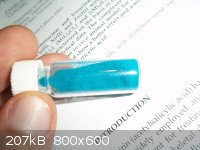
|
|
|
sargent1015
Hazard to Others
  
Posts: 315
Registered: 30-4-2012
Location: WI
Member Is Offline
Mood: Relaxed
|
|
Well, I am on vacation now, so my project here is on hold.
But I will say this, the iron aspirinate synthesis did yield a red-brown solid after the LONG gravity filtration (this is why I am looking for an
aspirator/pump currently  ). After I do get something for filtration, I will
attempt this synthesis again, but It does seem to work and it also seems stable. ). After I do get something for filtration, I will
attempt this synthesis again, but It does seem to work and it also seems stable.
I will post a picture of the product sometime next week.
|
|
|
cyanureeves
National Hazard
   
Posts: 744
Registered: 29-8-2010
Location: Mars
Member Is Offline
Mood: No Mood
|
|
darn it i threw away my copper aspirinate because it was aqua color and thought it was supposed to be dark navy blue like the one in the youtube
video.before i threw it away i added hydrogen peroxide to it and it turned yucky brown.
[Edited on 7-6-2013 by cyanureeves]
|
|
|
bfesser
Resident Wikipedian
    
Posts: 2114
Registered: 29-1-2008
Member Is Offline
Mood: No Mood
|
|
Adding hydrogen peroxide to the complex will yield muddy brown <a href="http://en.wikipedia.org/wiki/Copper(II)_oxide"
target="_blank">CuO</a> <img src="../scipics/_wiki.png" /> (similarly to <a href="viewthread.php?tid=17397"
target="_blank">copper(II) carbonate</a> . .
[Edited on 7/26/13 by bfesser]
|
|
|
bfesser
|
Threads Merged
7-7-2013 at 17:11 |
DrSchnufflez
Hazard to Others
  
Posts: 114
Registered: 22-1-2013
Location: Australia
Member Is Offline
Mood: No Mood
|
|
I attempted making it tonight by following the procedure for making copper (II) acetylsalicylate:
Approx 4g of acetylsalicylic acid was dissolved in 50ml of distilled water on an oil bath.
Nickel (II) carbonate was added bit by bit until no more would dissolve.
A distinct lack of gas evolution was noted during the addition of the nickel (II) carbonate.
This resulted in a very deep red bordering on black solution with a dark purple blue precipitate.
The precipitate was vacuum filtered off and the filtrate was set aside.
The precipitate was then washed on the frit with 99% propan-2-ol which resulted in a crimson coloured solution.
Upon looking at the first aqueous filtrate a layer of apparently red, opaque crystals had deposited.
Hash anyone attempted the synthesis of nickel(II) acetylsalicylate complexes?
Does anyone know of nickel exhibiting a deep red colour in solution?
Ill take some photos when I can gain access to a camera.
‘I’m free and easy-I’ll see you there!’
- Our Sunshine, Paul Kelly
|
|
|
prof_genius
Hazard to Others
  
Posts: 147
Registered: 15-5-2013
Member Is Offline
Mood: No Mood
|
|
I will try making it when I get new chemicals.
|
|
|
Boffis
International Hazard
    
Posts: 1867
Registered: 1-5-2011
Member Is Offline
Mood: No Mood
|
|
I can't reproduce your reaction> Tried two different approaches. First I repeat the experiment above with 0.53g of acetylsalicylic acid (M & B
lab grade) in 20ml of boiling water (about the minimum it will dissolve in) and added basic nickel carbonate until no more would dissolve even after
boiling for 10 minutes. The solution was slightly brownish red rather than green and was filtered quickly through a hirsh funnel and lefts to
cool/evaporate in a shallow basin. After 8hr a little brown liquid remains but no crystals yet. The insoluble excess carbonate was stained orange red
in places by tiny amorphous looking patches of another compound.
Next I dissolve 1.03g of acetylsalicylic acid in 40ml of boiling water and added 0.71g of nickel acetate tetrahydrate (2:1 M ration). The latter
dissolved to give a pale green solution but no crystal formed on cooling and the solution has remained pale green for about 7 hours. This is curious
since normally the acetylsalicylic acid crystallizes swiftly on cooling. The lack of crystals suggests that a more soluble complex has formed but it
appears to be green.
I report back if any crystals form.
[Edited on 21-8-2013 by Boffis]
|
|
|
bfesser
Resident Wikipedian
    
Posts: 2114
Registered: 29-1-2008
Member Is Offline
Mood: No Mood
|
|
Boiling <a href="http://en.wikipedia.org/wiki/Aspirin" target="_blank">acetylsalicylic acid</a> <img src="../scipics/_wiki.png" />
(ASA) in water will <a href="http://en.wikipedia.org/wiki/Hydrolysis#Esters_and_amides" target="_blank">hydrolyze the ester</a> <img
src="../scipics/_wiki.png" /> to <a href="http://en.wikipedia.org/wiki/Salicylic_acid" target="_blank">salicylic acid</a> <img
src="../scipics/_wiki.png" /> and acetic acid—you are aware of this, correct? The excess water and heat shift the equilibrium in favor
of the products.
<img
src="http://2012books.lardbucket.org/books/general-chemistry-principles-patterns-and-applications-v1.0/section_18/f574f030712b50f72c75ab7b0ebcd468.jpg
" width="500" />
[edit] If you want to prepare complexes of ASA from aqueous solution, first react the acid with a gentle base (e.g. NaHCO<sub>3</sub> to avoid hydrolyzing the ester. Then prepare a salt of your transition metal with a
weak acid (acetic is suitable). Mixing of the two solutions will precipitate an insoluble <a href="http://en.wikipedia.org/wiki/Chelate"
target="_blank">chelate</a> <img src="../scipics/_wiki.png" />, if you pick the right metal and conditions. to avoid hydrolyzing the ester. Then prepare a salt of your transition metal with a
weak acid (acetic is suitable). Mixing of the two solutions will precipitate an insoluble <a href="http://en.wikipedia.org/wiki/Chelate"
target="_blank">chelate</a> <img src="../scipics/_wiki.png" />, if you pick the right metal and conditions.
[Edited on 4.1.14 by bfesser]
|
|
|
sargent1015
Hazard to Others
  
Posts: 315
Registered: 30-4-2012
Location: WI
Member Is Offline
Mood: Relaxed
|
|
I agree with Bfessor, you need the weak base (bicarb) to react with the acetylsalicylic acid completely in solution before adding the metal salt, no
heat required. It will take a sizeable amount of stirring since sodium bicarb is not all that soluble either. I used 1:1.1 (bicarb:ASA) equivalence,
since you don't want any sodium bicarb left to react with the metal. After this, add a metal salt solution.
My guess is that the complex is insoluble in water, but then again doesn't nickel like to form octahedral complexes? In which cases it would be a
salt.
Does anyone have a reference for the Nickel complex we are trying to make?
|
|
|
Boffis
International Hazard
    
Posts: 1867
Registered: 1-5-2011
Member Is Offline
Mood: No Mood
|
|
@DrSchnufflez I have continued to monitor the experiments I did with nickel and aspirin and described above. The experiment with the nickel carbonate
produced no crystals even after a couple of days so I evaporated down on a hotplate on the minimum setting and ended up with a glassy semi-solid
reddish brown residue that still would not crystallise. I tried triturated it with alcohol but this made no obvious difference apart from the fact I
ended up with a cruddy mess. The fact that the aspirin itself wouldn't crystallise out from the residue does suggest that it has formed a complex with
the nickel.
With the nickel acetate-aspirin experiment I got a pale green glassy residue that also would not crystallise under any condition.
I think that the difference in colour is due to the partial hydrolysis of the aspirin to salicylic acid around the basic nickel carbonate and that it
is the salicylic acid that forms the red complex. In the nickel acetate experiment the nickel compound was added only after complete solution of the
aspirin so hydrolysis was minimal.
Contrary to the comments about aspirin above it can be recrystallized from boiling water, in the absence of an acid or alkali hydrolysis is slow and
in my experiment with nickel carbonate the boiling was not long enough to cause much hydrolysis except possibly in the immediate vicinity of the basic
nickel carbonate.
If you doubt the difference between the complexes of aspirin and salicylic acid are that great consider the difference between the respective ferric
complexes. That of aspirin is brown and insoluble while that of salicylic acid is deep purple and freely soluble. I have used this reaction many time
as a colorimetric method to analyse iron but I have never made it concentrate enough to know if you can crystallise the complex. The colour of the
ferric complex raises an interesting possibility; how pure is your nickel carbonate? Could it contain a little iron?
It should be easy enough to test this by repeating the experiment with salicylic acid, I am not at home at present so I can't try it but someone else
might.
|
|
|
bfesser
Resident Wikipedian
    
Posts: 2114
Registered: 29-1-2008
Member Is Offline
Mood: No Mood
|
|
Quote: Originally posted by Boffis  | | Contrary to the comments about aspirin above it can be recrystallized from boiling water, in the absence of an acid or alkali hydrolysis is slow and
in my experiment with nickel carbonate the boiling was not long enough to cause much hydrolysis except possibly in the immediate vicinity of the basic
nickel carbonate. |
This contradicts my past observations. Do you have empirical evidence to back up this
claim? I'd conduct some hydrolysis experiments and follow-up with melting point determinations, but my entire lab is stowed away in storage.
Regardless, I still think you're going about this all wrong... you shouldn't have to force anything to crystallize out. I'd expect the complexes to
be highly insoluble. Try as I suggested above, by using a weak base to deprotonate the acid, etc. I'd dig myself out of apartment hiatus and do it
myself, but I don't have any nickel salts.
|
|
|
DrSchnufflez
Hazard to Others
  
Posts: 114
Registered: 22-1-2013
Location: Australia
Member Is Offline
Mood: No Mood
|
|
That's very interesting Boffis,
My nickel carbonate was made by electrolytically dissolving a cupronickel spoon in iron free HCl. The resultant green liquor was filtered from the
copper sponge that had deposited on the lead cathode.
The nickel chloride was then precicpated as the carbonate by addition of a stoichiometric amount of sodium bicarbonate.
I will buy some more asprin, hydrolyse and try to make a nickel salicylic acid complex.
Also
bfesser, I shall try your method of making the Acetylsalicylic acid complexes using a weak base to deprotonate the acid.
‘I’m free and easy-I’ll see you there!’
- Our Sunshine, Paul Kelly
|
|
|
sargent1015
Hazard to Others
  
Posts: 315
Registered: 30-4-2012
Location: WI
Member Is Offline
Mood: Relaxed
|
|
Feels good to have some free time to do amateur chemistry again. It has been way too long since I have been in my home lab!
Well, time for another go at aspirinate complexes. This time, it is bis(aspirinato) bis(imidazole) Cu (II).
The procedure, modified from using 2-methylimidazole, is found in:
Abuhijleh, A. L. Inorganic Chemistry Communications, 14, 2011, 759-762.
Basically, imidazole is dissolved in ethanol and copper aspirinate is added directly to the reaction mixture. I hope copper aspirinate has enough
solubility to get into solution and react with the imidazole, since the solution is quite cloudy. I will let the solution stand overnight after
filtering and crash the product out (Hopefully) with ether tomorrow evening.
[Edited on 24-9-2013 by sargent1015]
|
|
|
violet sin
International Hazard
    
Posts: 1480
Registered: 2-9-2012
Location: Daydreaming of uraninite...
Member Is Offline
Mood: Good
|
|
I bought some aspirin the other day to undertake some of these reactions. started by dissolving 31 x 325mg aspirin in MeOH, going to distill off the
methanol tonight, hopefully be left with ~10g ASA to play with. a lot I know but didn't wanna make some for each rxn, and with the talk of ASA vs. SA
versions should have plenty for test tube size tests and perhaps more colors. also I was wondering if using an acetate salt of the desired metals
instead of the sulfate ( like in Cu version ) would have any ill consequences? still have some Ni(CH3COO)2 laying around from electro-chem fun and
thought it might make it gentle on the ASA or even not need the sodium bicarbonate portion. PURELY speculation on my behalf, but I thought I would
ask the opinions of members if it was a waste of time/materials. I still planned on doing things in the conventional manner but why not have a lill
fun. also what about heating the ASA with borax as the base? could lead to boron aspirinate perhaps. seems unlikely but again why not have a lill
fun n try.
I have Li, Na, Mg, Al, Ca, Ti, Cr, Fe, Co, Ni, Cu, Zn, Ga, Zr, Nb, Pd, Ag, In, Sn, Ta, W, Pt, Ag, Hg, Pb, Bi metals and a few other salts also. Deff
not going to try them all but I have some to work with for sure.
any thoughts?
-Violet Sin-
edit: realized I don't have a means to get some of those into sol. to participate though. I just love metals 
[Edited on 24-9-2013 by violet sin]
|
|
|
bfesser
Resident Wikipedian
    
Posts: 2114
Registered: 29-1-2008
Member Is Offline
Mood: No Mood
|
|
<strong>sargent1015</strong>, I very much look forward to reading (hopefully seeing) the results of your preparation! I've got a large
jar (500 g) of high purity <a href="https://en.wikipedia.org/wiki/Imidazole" target="_blank">imidazole</a> <img
src="../scipics/_wiki.png" /> that's been sitting unopened in my storage bins for many years. If I can find a safe place (i.e. not in my
apartment) I will try to conduct a parallel experiment to yours. Do you have a copy of that paper to share in References?
<strong>Violet sin</strong>, an acetate should work even better, as it is the salt of a weak acid, CH<sub>3</sub>COOH, rather
than the strong acid H<sub>2</sub>SO<sub>4</sub>. I suggest (see first post) washing out all the binder materials from
aspirin tablets with water before doing any recystallization. As for the boron idea; I'm no expert (speculating), but I don't think boron forms
coordination complexes with carboxylic acids. I'd be interested to see photos of the result of sucn an experiment, however—perhaps
something interesting would form.
|
|
|
DraconicAcid
International Hazard
    
Posts: 4332
Registered: 1-2-2013
Location: The tiniest college campus ever....
Member Is Offline
Mood: Semi-victorious.
|
|
Quote: Originally posted by violet sin  | also what about heating the ASA with borax as the base? could lead to boron aspirinate perhaps. seems unlikely but again why not have a lill fun n
try.
I have Li, Na, Mg, Al, Ca, Ti, Cr, Fe, Co, Ni, Cu, Zn, Ga, Zr, Nb, Pd, Ag, In, Sn, Ta, W, Pt, Ag, Hg, Pb, Bi metals and a few other salts also.
|
Don't use borax, or your metals may precipitate as the borate instead of the aspirinate.
Don't bother with the alkali metals- they won't precipitate with aspirinate. Don't bother with the alkaline earth metals or aluminum. If they do
precipitate, it will be a boring white material. I similarly wouldn't bother with titanium, zirconium, niobium or tantalum- these tend to stick with
their highest oxidation state, with no d-electrons to give lovely colours. The Cr, Fe, Co, and Ni have potential to give nice precipitates; the Pd
and Pt may work, but I wouldn't want to waste precious platinum on making an aspirinate. Things like mercury and lead I prefer to just leave on the
shelf.
Please remember: "Filtrate" is not a verb.
Write up your lab reports the way your instructor wants them, not the way your ex-instructor wants them.
|
|
|
violet sin
International Hazard
    
Posts: 1480
Registered: 2-9-2012
Location: Daydreaming of uraninite...
Member Is Offline
Mood: Good
|
|
@bfesser: the aspirin I got were from a discount store, only aspirin and starch if I am to believe the packaging. so they dissolved in the MeOH
rather nice leaving an absolutely clear sol. with a little dust in the bottom. was going to filter it and go from there. like 500 count bottle of
325mg pills for <3$ so if there is a prob I have more. also don't have a stirrer so would be all by hand to get the starch out. and cool beans I
was hoping the acetates would be easier/gentler.
@DraconicAcid: I wasn't planning on using borax as the base to get Na(ASA), but rather, was hoping the basic nature of the borax itself with sodium
roaming around would allow the borate to complex. kinda opening its own door to a precipitate as it were. who knows something may come of it. I
read a bit on boron and zinc aspirinates(or at least salicylate), but it was on some hippy looking site about healing stuff, tonics and all. and I
couldn't find any scientific papers to back any of it up.
http://cancernaturaltherapyfoundation.org/nl/200909.pdf
"In addition to copper salicylate complexes also a salicylate complex with zinc and boron is a good healing remedy. This has been called the
Schweitzer Formula, and is formed from zinc (oxide or carbonate), boron (boric acid) and salicylic acid. It has been used as an antibiotic,
disinfectant, fungicide, and anti-inflammatory agent
The Schweitzer Formula supposedly was developed 1915 in Germany and sold worldwide since 1920. In addition to any kind of infection or
inflammation, it has been used in cancer treatment, to improve the immune response and blood oxygenation. Applied externally it is
claimed to heal injuries and skin diseases, including acne, scarring varicose veins and varicose ulcers. To make the Schweitzer Formula
dissolve 9.2g of salicylic acid, 2.1g of boric acid and 2.7g of zinc oxide or 4g of zinc carbonate in 2 litres of hot water. You may get these
ingredients from a pharmacist or supplier of fine chemicals and have these quantities weight out. However, it is sufficient to use approximate
amounts. You may use 2level teaspoons of salicylic acid and half a teaspoon each of boric acid and zinc oxide or one level teaspoon of zinc
carbonate"
when they use words like supposedly and give a by volume measurement for recreating the mix, I have serious doubts.
also I know a bunch of the metals I listed are impractical for this. but I been collecting for a while so they got added on the list.
unfortunately I didn't get enough done last night and am going out of town again today here in a couple hours so any progress is going to have to wait
a week or so. our baby shower is this sunday n I'm trying to get some work in before I come back so I may be gone a few weeks. 
-Violet Sin-
|
|
|
bfesser
Resident Wikipedian
    
Posts: 2114
Registered: 29-1-2008
Member Is Offline
Mood: No Mood
|
|
Quote: Originally posted by violet sin  | cancernaturaltherapyfoundation.org
. . .
when they use words like supposedly and give a by volume measurement for recreating the mix, I have serious doubts. |
You should have had doubts as soon as you saw the domain name. Also, any published media using <a
href="https://en.wikipedia.org/wiki/Papyrus_(typeface)" target="_blank">Papyrus</a> <img src="../scipics/_wiki.png" /> immediately
loses any and all potential credibility.
<img src="http://www.cancernaturaltherapyfoundation.org/images/natures_way.gif" />
<a href="http://www.cancernaturaltherapyfoundation.org/health-articles-view.php?id=2" target="_blank">Copper Salicylate: A Potent Inflammation
Fighter and Rejuvenator</a> — Walter Last
The references are unimpressive at best and—as far as I see—the author has no qualifications to speak of.
[Edited on 24.9.13 by bfesser]
|
|
|
sargent1015
Hazard to Others
  
Posts: 315
Registered: 30-4-2012
Location: WI
Member Is Offline
Mood: Relaxed
|
|
Well looks like I am out of ether for the time being, probably whip up a quick batch soon. For now, evaporation will be the key to finding if I made
the correct complex.
Bfesser, here is the reference, check the cited works for the synthesis, #14, and realize that this is for 2-methylimidazole, my hopes is that I do
not need that methyl group to get the imidazole to complex.
http://www.sciencemadness.org/talk/viewthread.php?tid=26316#...
Violet Sin, I have an article on several different metal aspirinates, apparently they all follow the same synthetic procedure, however my cobalt (II)
aspirinate didn't crash like it was supposed to. Check the thread above for the paper.
And just because I like pretty pictures, here is the current state of my product.
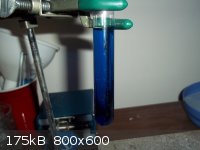
I love the beautiful dark blue solution, which makes me quite hopeful. The 2-methylimidazole version claims purple crystals, so I wonder if these will
be similar.
|
|
|
bfesser
Resident Wikipedian
    
Posts: 2114
Registered: 29-1-2008
Member Is Offline
Mood: No Mood
|
|
Hmm. I thought I had some <a href="http://monographs.iarc.fr/ENG/Monographs/vol101/mono101-014.pdf" target="_blank">2-methylimidazole</a>
<img src="../scipics/_pdf.png" />, but after searching through my bins I was only able to find an unopened 500 g bottle of Fisher <a
href="http://www.fishersci.com/ecomm/servlet/fsproductdetail_10652_632433__-1_0" target="_blank">certified imidazole</a> <img
src="../scipics/_ext.png" /> and an unopened 5 g bottle of <a
href="http://www.sigmaaldrich.com/catalog/product/aldrich/425842?lang=en®ion=US" target="_blank">4-imidazolecarboxylic acid</a>
<img src="../scipics/_ext.png" />, 98% from Aldrich. I guess my memory was flawed. Until now, I had no idea they were so valuable—I
doubt I payed more than $20 each! 
<hr width="80%" />
I've noticed that there's been <a href="viewthread.php?tid=26095">recent interest</a> in the coordination compounds of <a
href="https://en.wikipedia.org/wiki/Ethylenediamine" target="_blank">1,2-diaminoethane</a> <img src="../scipics/_wiki.png" />. Perhaps
one of the participants [cough]<strong>woelen</strong>[cough] in that thread could attempt the synthesis of 2-methylimidazole as outlined
in this paper:
<table><tr><td width="20"></td><td><strong>The staged synthesis of 2-methylimidazole from ethylenediamine and
acetic acid in the presence of a bifunctional aluminoplatinum catalyst</strong><br />K.M. Gitis, N.I. Raevskaya, G.V. Isagulyants<br
/><em>Bulletin of the Russian Academy of Sciences, Division of chemical science</em>.September 1992, Volume 41, Issue 9, pp 1551-1554.
DOI: <a href="http://dx.doi.org/10.1007/BF00863570" target="_blank">10.1007/BF00863570</a> <img src="../scipics/_ext.png"
/></td></tr></table>
The preparation of the γ-Al<sub>2</sub>O<sub>3</sub>/Pt catalyst would be interesting and challenging in and of
itself. The whole project from 1,2-diaminoethane to the final complex would make an excellent addition to <strong><a
href="forumdisplay.php?fid=20">Prepublication</a></strong>.
<a href="viewthread.php?tid=25035&page=7#pid300833">[reference requested]</a>
P.S. <strong>woelen</strong>, I know that you <a href="viewthread.php?tid=15513">'have a thing for copper'</a>—how
can you resist? 
|
|
|
Oscilllator
National Hazard
   
Posts: 659
Registered: 8-10-2012
Location: The aqueous layer
Member Is Offline
Mood: No Mood
|
|
This isn't stricly speaking an aspirinate synthesis, but I thought I'd post it here anyway.
Recently I successflly made a copper/salicylic acid complex from copper sulfate using the procudure that bfesser outlined, although I didn't bother to
measure out the reagents.
It is interesting to note that although the aspirinate complex is insoluble, the salycilic acid complex is very soluble, having a deep green colour
similar to a concentrated solution of nickel nitrate.
Here is a picture of the compound after vacuum filtration:
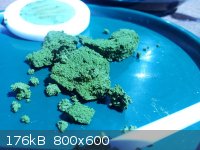
I also attempted to prepare a nickel analogue, however is seemed that only nickel carbonate formed 
|
|
|
| Pages:
1
2
3
4
5
6 |